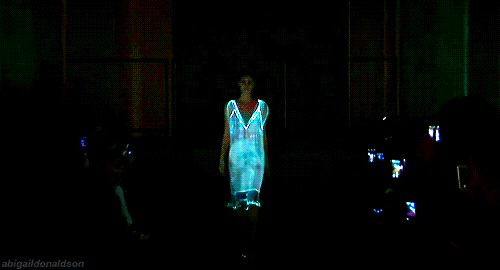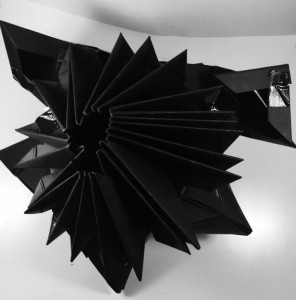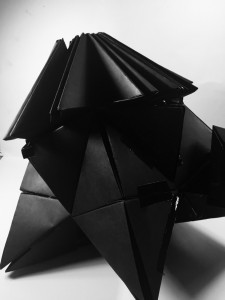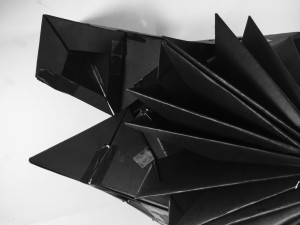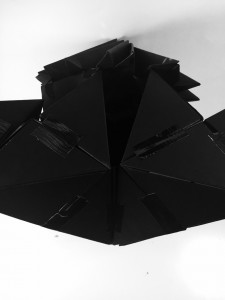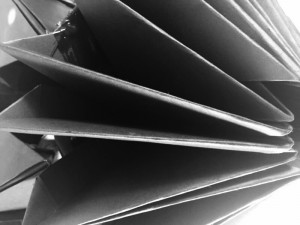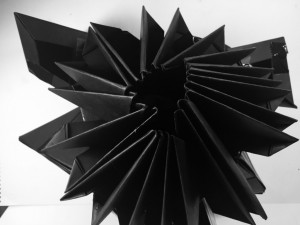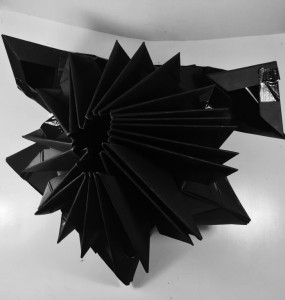This is my model of a garment that is inspired by Iris Van Herpen’s spring/summer 2010 haute couture. For my previous project I had made a book using technology. I wanted to experience what it was like to make something by hand and how different I would feel about the object I make. For this garment I used black paper. I folded the paper into swan pieces and pieced them together. I wanted the tape to be visible to show the struggles and time that I had placed into the design. However, even though the final product had many faults, I felt more attached to it and I learned how the material itself work. I was more proud of the hard work that I had placed into the piece. While putting this together, I ran into many issues on how to attach the pieces. Glue (krazyglue, hot glue, etc) was not holding the pieces together due to the overall weight of all the pieces of paper.
Modern-Day Transformers
During the 2016 Met Gala, Claire Danes’s glow-in-the- dark gown, designed by Zac Posen, exploded throughout social media causing a frenzy by bringing awareness to how technology is revolutionizing the world; specifically, the world of fashion. As the world becomes more technologically advanced and integrated, fashion designers are finding new ways of combining handmade creations with machine-made creations. The connection between the two is highlighted through Manus x Machina, an exhibition that consists of both handmade and machine-made creations of haute couture. Included within the exhibition is Iris Van Herpen’s spring/summer 2010 haute couture ensemble from her 2010 “Crystallization” collection. This ensemble demonstrates the perfect bridge between handmade and machine made clothing.
Iris Van Herpen’s spring/summer 2010 haute couture ensemble was Herpen’s first 3D printed creation with Materialize and Daniel Widrig, a fellow architect. Shape plays an important role in Herpen’s overall design. The top is skeletal and is composed of polyamide that has been laser printed. The smooth shape has a dynamic quality and is innovative and unique. The top is composed of two big pieces overlapped with six smaller pieces that are varied in size on the sides. Despite the different size of the pieces, the top is symmetrical and can be split in half straight down the middle. Each piece of the top guides your eyes in a circular motion. In the middle of the pieces is an oval section of negative space. This negative space in between the pieces and the overlapping of the pieces gives the top a more dramatic 3D design by creating the illusion of space. Even though the individual structures of the pieces are edgy and a bit masculine, the overall structure seems more feminine and delicate. Instead of making the top even more complex, Herpen used a simple color palette giving it a more timeless effect. Even though the shape abstracts the human figure, the shape of the human figure is evident through the spaces in between the structure. In fact, it highlights the shape of the human body. The way the structures overlap and touch also seems like how the systems of the human body interacts with each other to carry out a specific task.
Along with the top, Herpen also designed a skirt. The skirt is composed of acrylic and leather. It is split horizontally into six equal sections and in between the sections are white acrylic fringes. The fringes are neatly organized giving it a symmetrical look. The creases that are created on the skirt due to the material makes the skirt look more organic. Rather than making the skirt off-white like the top, Herpen decided to make the dress pure white making it stand out especially under the light. The texture of the skirt is glossy and smooth giving it an elegant element.
Garments were traditionally made by hand. They are often sold at a higher price due to the hard work and time that designers have placed into them. Designer Jonathan Simkhai stated that designers that make the garments by hand understand the “intricacy of the detailing as well as the fact that they are buying a one-of-a-kind design, or one of which only a handful were produced.” (Fleming, Olivia. “Are Handmade Clothes Really Better Than Machine Made Clothes?” May 6, 2016. Accessed July 19, 2016.) This means that handmade garments are seen as being more rare due to the detailing of it. According to Julie Heller, owner of the appointment-only designer vintage store EraLuxe Gallery, “People will always want old school pieces of manufacturing, the kind that need that touch and element of construction.” The process of hand making the garments is an artwork itself and requires intense concentration in planning and sketching out the design and figuring out the measurements. It gives the designer a more personal attachment to the garment therefore making it more meaningful. Handmade garments also require many techniques that require skills in order to manipulate the fabric to create different textures.
The process of hand making a garment can take up to several days and at times even months. However, designers working by hand are less vulnerable to mistakes. Designers first plan out their design, some mentally and some make patterns. In this step, the designer determines the shape, color, and fabric that she/he desires. The next step is preparation. The designer prepares his/her design, his/her finished pattern and other materials that will be needed for the design. The designer makes sure that the shape of the garment is correct and also the fitting itself. After preparation, is closure. Here, the designer would complete the garment and add small details. Materials in this process may contain, buttons, zippers, and hooks. The designer would then address any troubleshooting that occurs. Lastly, the garments would then be professionally “finished”, any last minute problems would be resolved before it is displayed or sent out to the runway. (Prendergast, Jennifer. Sewing Techniques: An Introduction to Construction Skills within the Design Process. (Bloomsbury Publishing, 2014). Morgan Rauscher, an interactive creative electronics artist, prefers making things by hand because he believes that by making something by hand is more beneficial to the designer because of tactility. Rauscher believes that by physically interacting with the material, the designer can gain more knowledge of the material and what the material has to offer to the design. (“Machine-Made Vs. Hand-Made,” Morgan Rauscher, December 2, 2013, accessed July 28, 2016.) Rauscher sees significance in the mental and physical relationship that takes place when a designer makes a garment by hand. He believes that by “working with materials directly, it forms a cyclical interactive partnership between the artist’s mind, hands and material.” (“Machine-Made Vs. Hand-Made,” Morgan Rauscher, December 2, 2013, accessed July 28, 2016.)
When incorporating technology into a garment, there are many factors to take into consideration. According to Seymour, these factors include: body wearability, perception, functionality, technology, materials, energy and recycle. Body wearability includes the placement, sizing, weight, comfort, compartments, and human movement of the garment. (Seymour, Sabine. Fashionable Technology. (Springer Wien NewYork, 2008), 23. Perception is the way the garment looks or the aesthetics of the piece. Functionality is how the garment interacts with the body and how the wearer controls it. Technology is how sensors are embedded into the garment. Materials included the type of textile the garment is composed of, the washing/cleaning quality of the garment, and the durability of the piece. Energy includes batteries, solar, kinetic energy that can be used to power an electrical component of the garment. And recycle is the ecological and biodegradable aspects of the materials used for the garment. All these components are essential in creating a wearable technology that is durable as well.
Like Herpen’s designs, other designers are beginning to find ways to incorporate technologies into their designs. Wearable technologies include the electrical engineering, physical computing, and wireless communication networks that makes a garment functional. According to Sabine Seymour, a designer and researcher that is known for her research and publications about technology and design, technology amplifies fantasy and transforms garments into interactive interfaces. Seymour, Sabine. Fashionable Technology. (Springer Wien NewYork, 2008), 12. Technology encourages creativity by making it possible for designers to create textiles and designs through the use of other materials. In an interview with Iris Van Herpen, Riley Montana, a current model, asked Herpen how she started working with 3D printing and why she chose to work with technology. Herpen replied, “ The 3-D printing is a story on its own, and it’s actually funny that I started doing it, because as a designer I really admire craftsmanship and working with my hands, and 3-D printing is sort of the opposite—it’s designing on the computer, and then a computer is making it. There is no hand involved in the whole process except for computer work. But for me, the technique is so inspiring because I can create different shapes and a different complexity than when I work with my hands.” (“Models Off Duty: Riley Montana X Iris Van Herpen,” Interview, June 19, 2014, accessed July 28, 2016.)
In contrast to making a garment by hand, technology can further enhance the functionality of clothing and is also capable of mimicking skin’s properties. By incorporating technology into a garment, the garment can be transformed into an interactive interface. (Ibid., 12.) This allows viewers to have their own personal experience with the garment itself. An example of this is Hussein Chalayan’s “Kaikoku” floating dress that is also a part of the Manus x Machina exhibition at the MET. Chalayan’s dress contains a remote control that sends Swarovski crystal “pollens” flying when pressed. The remote control in this case, is the “interactive” aspect of the garment.
Much research is done in trying to incorporate technology into garments. Designers often work alongside with scientists, technicians and at times architects. The functionality of the garment are then designed in a way so that it works. Technology are often embedded into the garments. The technical components used to create wearables are: “interfaces (connectors, wires, antennas…), microprocessors, inputs (sensors…) outputs, software, energy (batteries, solar panels…) and materials like electronic textiles.” (Ibid., 17.) The person wearing the garment controls the inputs. They include: textile sensors and embedded sensors. Textile sensors are sensors that are directly applied into the textile. They measure stress, temperature, and gas. Embedded sensors are embedded within the garment; as a result, the placement of the sensors is extremely important. These sensors can measure distance, temperature, sound and even smell. (Ibid., 17.) Outputs stimulate the five senses of the viewer. If a designer wants to stimulate the sense of vision, she/he would add LEDs, E-ink (paper-like display technology), photochromic inks, etc into the design. To stimulate the sense of sound, the designer may add speakers and buzzers into the garment. And to stimulate the sense of touch, the designer may add motors, conductive yarn, conductive fabrics, etc into the design. (Ibid., 19.) These technologies all work together to allow garments to move and light up without human control.
Because of the shift towards technology and away from handmade, it brings up the question of communication between the workers. When it comes to handmade garments, designers often work with other designers and pattern makers to create the design. This makes communication between the workers extremely important. Many may believe that by shifting towards technology, there will be a lack of communication between the designer and the other workers. This belief is not true. By shifting towards technology, communication will still be extremely important. However, instead of working with seamstresses and pattern makers, the designer would be working along side with technicians, architects, electricians, and even scientists to collect information on the specific material or function the designer desires to achieve. In an interview, Julia Körner , an architect that worked with Herpen on her 3D printed garments, agreed that technology is revolutionizing the world of fashion and that the experience of working with technology is a very “exciting moment in fashion design” and that technologies like body scanning and 3D modeling allows the designer to design a garment with a perfect fit with “minimal changes” in coding. This means that instead of re-making an entire pattern for a garment by hand and having to restart the entire process of sewing, a designer can simply digitally adjust the coding of a garment to change the measurements, making it more convenient and more accessible to the designer as well. So will technology further revolutionize the world of fashion uniting handmade and machine-made garments or will technology create a wall between the two?
Works Cited
Bolton, Andrew. Manus x Machina: Fashion in an Age of Technology. Yale University Press, 2016.
Code and Theory. “Models Off Duty: Riley Montana X Iris Van Herpen.” June 19, 2014. Accessed July 28, 2016. http://www.interviewmagazine.com/fashion/models-off-duty-riley-montana-x-iris-van-herpen/#_.
Fleming, Olivia. “Are Handmade Clothes Really Better Than Machine Made Clothes?” May 6, 2016. Accessed July 19, 2016. http://www.harpersbazaar.com/culture/features/a15510/are-handmade-clothes-really-better-than-machine-made-clothes/.
Prendergast, Jennifer. Sewing Techniques: Introduction to Construction Skills within the Design Process. Bloomsbury Publishing, 2014.
Rauscher, Morgan. “Machine-Made Vs. Hand-Made.” December 2, 2013. Accessed July 28, 2016. http://morganrauscher.com/morganrauscher/2013/12/02/machine-made-vs-hand-made/.
Seymour, Sabine. Fashionable Technology: The Intersection of Design, Fashion, Science, and Technology I. Springer Publishing Company, Inc., 2008.
Seymour, Sabine. Functional Aesthetics: Visions in Fashionable Technology. Springer Vienna, 2010.
Tortora, Phyllis G. Dress. Fashion, and Technology: from Prehistory to the Present. Bloomsbury Publishing, 2015.
